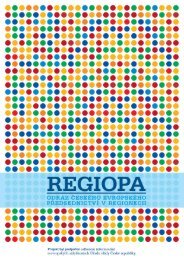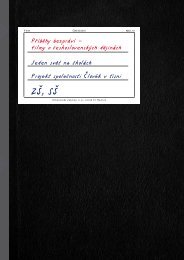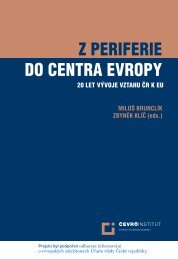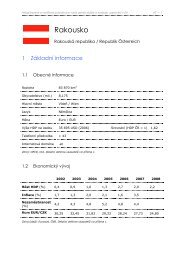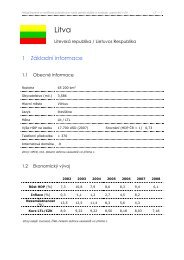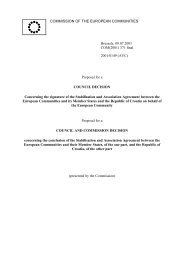CESTA KE SVOBODÄ PÅÃBÄHY BEZPRÃVÃ - Euroskop.cz
CESTA KE SVOBODÄ PÅÃBÄHY BEZPRÃVÃ - Euroskop.cz
CESTA KE SVOBODÄ PÅÃBÄHY BEZPRÃVÃ - Euroskop.cz
- No tags were found...
Create successful ePaper yourself
Turn your PDF publications into a flip-book with our unique Google optimized e-Paper software.
STORIES OF INJUSTICE – THE ROAD TO FREEDOMThis year, the People in Need foundation is organising an exhibition about the totalitarianera in Czechoslovakia from 1948 to 1989 which will be held under the statue of St. Wenceslason Wenceslas Square. Last November, we constructed a labour camp with barbed wire,watchtowers and searchlights at this location, which is of symbolic importance to the Czechnation. We filled this camp with portraits of political prisoners. By doing this, we primarilywanted to show how widespread the political repression of that era was. Very often, thepeople imprisoned behind bars and barbed wire were only there because of their familybackground, religious beliefs, social standing or the property they owned. If the putsch of1948, which the communists called “Victorious February”, were to happen today, anyone ofus could end up being a victim like those who were persecuted in the past.For a long time, Czech society has not dealt with the injustices of the communist regimeor rather not dealt with them to an appropriate extent. Despite this, there is undoubtedlywidespread awareness today that innocent people were horribly wronged during thetotalitarian era. One group of people who are still overlooked, however, are those whoresisted communism and who decided at great personal risk to themselves that they wouldnot simply stand by and watch, but would take action. This year’s exhibition focuses ondescribing the fate of some of these individuals. It’s only a slight exaggeration to say that thecommon perception in this country is that it was only the Mašín brothers (whose actions, ofcourse, are seen as an example of extreme resistance) who defied totalitarianism in the 1950swhile Václav Havel and the Charter 77 movement confronted it during the “normalisation”era, which followed the Warsaw Pact invasion of our country in 1968. (The Charter 77movement is often viewed as a whole, without any emphasis being placed on the individualsignatories). In fact, there were actually thousands of people who resisted the cruel andbarbaric policies of the Czechoslovak Communist Party. At the same time, it is necessary tostress that they accounted for just a small fraction of a nation of several million people. Thisis all the more reason why we are devoting our attention to them.Why has this not been done before now? It is undoubtedly a complicated, disturbingquestion, which cannot be easily answered. Consequently, we shall only make a fewcomments on this issue. It seems to us that one reason is that there is a kind of defeatisttradition at work in this country. This is a national myth that people have been able tolive with very easily. It offers a very “convenient” explanation and supports the view thathistory is something that actually occurs by itself. History is seen as something that isinfluenced by the actions of the political elite and individuals cannot do anything aboutit. They can only try and come to terms with it and passively accept what happens. Thissort of explanation effectively excludes any thoughts of responsibility or guilt. When wecan’t do anything about it, why should we dwell on our own actions? This interpretationof history offers an expedient way for explaining for the victims of the totalitarian regime.(They would have ended up in prison or on the gallows anyway, irrespective of theirown actions). Unfortunately, dissidents and resistance fighters don’t sit well with thistheory. They defy any comfortable defeatist interpretation of what happened and theyexpose the falsity of such thoughts. These people remind us that nobody is ever divested oftheir own personal responsibility or of the need to decide for oneself and to take a stand.Naturally, not everybody has the same opportunities, or the same courage, tenacity anddetermination. Nonetheless, there is no such thing as an individual who is inevitablypredestined to collaborate, denounce or betray.The people whose portraits are included in the exhibition and in this publication foundextraordinary strength to resist, and they are very much part of our road to freedom. In ouropinion, these people’s efforts should be praised and they should be held up as an importantyardstick for the whole of society. They should not be hidden from view or pushed into thebackground. We have tried to select personalities who represent various forms of resistanceto totalitarianism. The people who are represented were members of anti-state resistanceorganisations. They worked for the secret services of democratic regimes, and they producedand distributed pamphlets. Also included are those who chose the most radical optionfor objecting to the state of society and political representation by committing suicide asa form of protest. We also present those who resisted in the cultural sphere – who publishedsamizdat literature, worked in civic initiatives, held demonstrations and organised petitions.They were convicted and imprisoned for their attitudes and their beliefs. Many of them paidfor their courage and determination with their lives.We are well aware that some might object to the people we have selected. It could beargued that different members of the anti-communist resistance should have been chosenor that others should have been excluded. Nevertheless, given the form of presentation, itis not possible to include everyone who actively and bravely put up resistance. First andforemost, we wanted to provide examples of various forms of protest. We tried to findsymbolic representatives of the dissident movement whilst also picking people whose fateis not so well known. It goes without saying that we also respect and admire those whohave not been included in this event.The design of the exhibition represents a symbolic labyrinth, whose walls displayphotographs taken at key moments in our country’s post-War history. They depict eventsthat substantially influenced the lives of every citizen in what was then Czechoslovakia.In those days, there were thousands of people who took to the streets to express supportand to protest. They let themselves be gripped by the tumultuous atmosphere of thosetimes. This soon faded, however, and gave way to a dreary existence, which became a mazethat one had to negotiate every day as best one could. Visitors to the exhibition are alsoentering a labyrinth, which contains portraits of people who at one time found a waythrough the morass. Some brief information on the fate of these people is included in theevent and there are also samples of documents from the relevant era. The labyrinth canalso be understood as a symbol in another sense, in that it represents the complicated andtortuous road Czechs had to take to gain their freedom.The courage and determination of the people you will encounter at the exhibition is alsostill very inspiring today. We too are moving through a labyrinth where we strive to findthe correct path every day. Nowadays, we also have to decide (albeit under incomparablyeasier conditions) whether it is necessary to remain true to our convictions and to act inan honourable and ethical manner. We are fortunate that this is nothing more than anunpleasant task for us, and that we are not threatened with prison or the gallows.I would like to thank everyone who participated in the preparation of the exhibition.Karel StrachotaDirector of the Stories of Injustice project10 | 11



